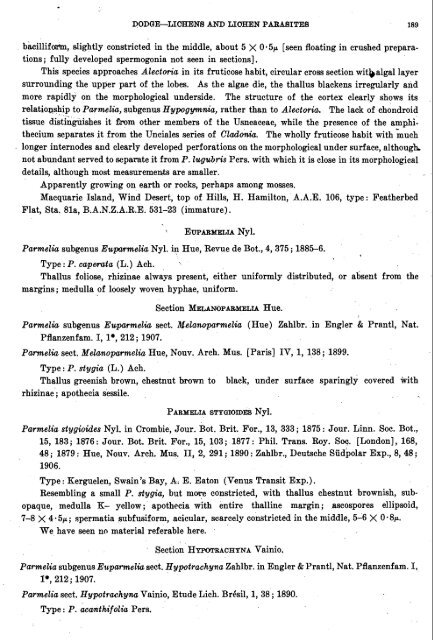You also want an ePaper? Increase the reach of your titles
YUMPU automatically turns print PDFs into web optimized ePapers that Google loves.
DODGE-<strong><strong>LICHEN</strong>S</strong> <strong>AND</strong> LIUHEN <strong>PARASITES</strong> 189<br />
b&illifm, slightly constricted in the middle, about 5 X 0-5p [seen floating in crushed prepara-<br />
tions; fully developed spermogonia not seen in sections].<br />
This species approaches Alectoria in its fruticose habit, circular cross section witbalgal layer<br />
surrounding the upper part of the lobes. As the algae die, the thallus blackens irregularly and<br />
more rapidly on the morphological underside. The structure of the cortex clearly shows its<br />
relatiopship to Pwmelia, subgenus Hypogymnia, rather than to Alectoria.. The lack of chondroid<br />
tissue distinguishes it h m other members of the Usneaceae, while the presence of the amphi-<br />
thecium separates it from the Unciales series of Cladonia. The wholly fruticose habit with much<br />
longer internodes and clearly developed perforations on the morphological under surface, although<br />
not abundant served to separate it from P. lugubris Pers. with which it is close in its morphological<br />
details, although most measurements are smaller.<br />
Apparently growing on earth or rocks, perhaps among mosses.<br />
Macquarie Island, Wind Desert, top of Hills, H. Hamilton, A.A.E. 106, type: Featherbed<br />
Flat, Sta. 81a, B.A.N.Z.A.R.E. 531-23 (immature).<br />
'. EUPARMELIA Nyl.<br />
Parmelia subgenus Euprmelia Nyl. in Hue, Revue de Bot., 4,375 ; 1885-6.<br />
Type : P. capmta (L.) Ach.<br />
Thallus foliose, rhizinae always present, either uniformly distributed, or absent from the<br />
margins; medulla of loosely woven hyphae, uniform.<br />
Section MELAN~WARMELIA Hue.<br />
Parmelia subgenus Euparmelia sect. N.elanupa.maelia (Hue) Zahlbr. in Engler & Prantl, Nat.<br />
Pflanzenfam. I, I*, 212 ; 1907.<br />
Parmelia sect. Melamoparmelia Hue, Nouv. Arch. Mus. [Paris] IV, 1, 138; 1899.<br />
Type : P. stygia (L.) Ach.<br />
Thallus greenish brown, chestnut hrown to black, under surface sparingly covered with<br />
rhizinae ; apothecia sessile.<br />
PARMELIA STYQIOIDES Nyl.<br />
Parmelia stygioides Nyl. in Crombie, Jour. Bot. Brit. For., 13, 333; 1875: Jour. Linn. Soc. Bot..<br />
15, 183 ; 1876 : Jour. Bot. Brit. For., 15, 103 ; 1877 : Phil. Trans. Roy. Soc. [London], 168,<br />
48 ; 1879 : Hue, Nouv. Arch. Mus. 11, 2, 291 ; 1890 : Zahlbr., Deutsche Siidpolar Exp., 8,48 ;<br />
1906.<br />
Type : Kerguelen, Swain's Bay, A. E. Eaton (Venus Transit Exp.).<br />
Resembling a small P. stygia, but more constricted, with thallus chestnut brownish, sub-<br />
opaque, medulla K- yellow ; apothecia with entire thalline margin ; ascospores ellipsoid,<br />
7-8 X 4-5p; spermatia subfusiform, acicular, scarcely constricted in the middle, 5-6 X 0.8~.<br />
We have seen no material referable here.<br />
Section HYPQTRACHYNA Vainio.<br />
Parmelia subgenus Euparmelia sect. Hyptrachyna Zahlbr. in Engler & Prantl, Nat. Pflanzenfam. I,<br />
I*, 212 ; 1907.<br />
Parmelia sect. Hypotraehynu Vainio, Etude Lich. BrCsil, 1, 38 ; 1890.<br />
Type : P. acanthifolia Pers.

















